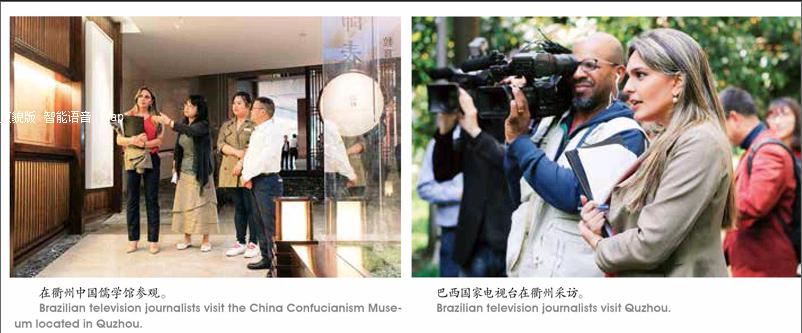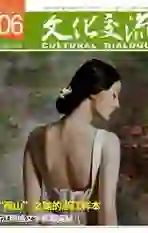巴西记者眼中的衢州人文
2017-06-13陈霞范少杰
陈霞?范少杰

衢州,成为巴西国家电视台此次来中国采访拍摄北京、杭州后的第三座城市。衢州凭借什么吸引国际眼球?三天之中,巴西记者辗转三衢大地,以自己的视角聚焦人文风貌、解码人文之美。
2017年9月,中国将举办金砖国家领导人第九次会晤。不久前,同为金砖国家的巴西,应邀到中国拍摄一部主题为《中国的改革发展成就》的纪录片,向巴西民众介绍中国城市面貌,展现中国的经济发展及人文风貌的现状与前景,增强中国在巴西的影响力。
教育是一个民族文化传承的依托
“我本人十分想念母校的这个公园,在中国,人们认为有水的地方就能聚集灵气。”曾就读于衢州二中的中国中央电视台海外联络部领队付为民,一踏进校园,指着一池绿水,向巴西国家电视台摄制组人员介绍。
衢州行,四名巴西记者在两名中国同行的陪同下,首先来到这座名校采访。
“在巴西,中学校园只是一栋楼房。”巴西电视台主持人普丽西拉看着周边郁郁葱葱的校园景色不由感叹:“这里看起来就像一所大学,如此美丽的校园一定能为学生带来很多灵感。”
在校史馆,双方畅聊起两国的教育。巴西记者就“中国的高考对学生来说有多重要?通过高考可以考核学生哪方面能力?”等问题进行了采访。衢州二中校长潘志强回答:“高考可以考验一个学生对知识体系的掌握情况,反映学生对人生的定位与追求,部分学生愿意付出更多的时间和精力来完成学业,取得更高的目标。”
巴西记者十分关注中国教育模式,对中国高考实情也充满好奇。“今天的学生就是中国的明天以及未来,教育是科学知识和民族文化传承的重要依托。”在图书馆内,普丽西拉向学生们了解他们如何准备高考以及平时的学习生活状况,她认为两国教育都有值得彼此学习和借鉴的地方。
“中國目前正在面临新高考改革,改革后把更多的选择权还给学生,试卷难度在下降,对学生的综合能力要求却越来越高,这也是中国教育未来的趋势。”潘志强向巴西记者介绍,学校在不断寻求更适合学生发展的氛围来感化学生,提倡师生平等相处,或是以学生为中心,重点培养学生的核心价值观。
“把衢州作为采访城市,是因为衢州文化底蕴深厚,并且有不错的发展。”付为民说,选择衢州二中作为其中的一个拍摄点,是其开放的校园环境和浓郁的国际化气息吸引着他们。
近年来,衢州二中已经与加拿大、丹麦、瑞典、德国和韩国等国家的学校结成国际友好交流学校,致力于开展国际理解教育,为学生提供大量参与国际交流的机会。巴西记者因此提到,校方是否会担忧外国文化对中国文化的冲击。潘志强回答:“我们在传承民族文化的大背景下吸纳更多的外国经验,学好外国语,做好中国人。”
“衢州二中是一所包容的学校,自然会吸纳不同文化背景、语言、肤色的人进入校园。”潘志强表示,教科书不是学校的世界,世界才是学校的教科书,培养“具有中国文化底蕴、同时又具有国际视野和沟通能力的学生”是学校的办学宗旨之一。
文化是一座城市的底蕴与风貌
天蓝水绿,鸟语花香。在弥漫着浓厚的中国传统文化氛围的衢州孔氏南宗家庙,孔子第75代嫡长孙孔祥楷先生在后花园大中堂以品茗会客,与巴西记者畅谈孔夫子思想对中国乃至世界的影响,以及孔子的主要教育理念。
孔祥楷先生提到,“中国教育很大程度上受孔夫子影响,例如2500多年前,孔夫子说有教无类,就如今天所提倡的教育平等。孔夫子主张和平,提倡政权掌握者爱护平民百姓等理念,也符合各国人民的希冀,所以现在有很多思想家、学者来中国,将孔子思想翻译为本国文字带回自己国家。”
不仅是儒学文化,极具礼制性特色的建筑与庭院景观也吸引着巴西记者的眼球。采访完孔祥楷先生后,巴西摄制组在园内取景、留影甚多,他们觉得“这里非常特别,很有纯正的东方韵味”。
中国儒学馆是传承弘扬优秀传统文化生动有效的载体和平台,巴西记者在集儒学文化的体验中心、展示平台、传承推广中心和儒学典籍的收藏中心于一体的儒学馆内,细细聆听工作人员讲解后,再进行拍摄,希望将更多的中国儒学文化精髓带回巴西。
琳琅满目。衢州市博物馆一具高达4米的“礼贤江山龙”骨骼化石,令巴西记者惊叹不已。“小小一座城市,这里的馆藏文物太丰富了,有3万余件,开馆至今已接待观众700余万人次……”巴西记者向工作人员详细了解内容后,一遍遍背诵,再通过镜头、话筒转述给巴西民众。“历史从博物馆开始。”
“我们走”“我是记者”“太美了”……一路上,巴西摄制组成员普丽西拉闲时就向翻译学习简单中文,她表示中国是个有趣的国家,所以她想学习中文,虽然中文于她而言比较难学。
傍晚时分,水亭门夕阳醉美,巴西记者用镜头记录下了这一幕,语言不同的他们不断直呼“真漂亮”。城楼上,普丽西拉用手机录了一段视频,发到社交平台,把所见所闻介绍给她的朋友。
衢州只是中国的一个剪影,它的风貌风情,通过巴西国家电视台的传播在继续。在衢州,巴西记者还到了纪念中华第一神针、明代针灸大师杨继洲的“针圣”故里及九龙湖风景区等地采访拍摄。他们告诉笔者,虽然时间短暂,但已经感觉无论自然还是人文,衢州“是一座非常美丽的城市”。
(本文摄影:陈霞)
Journalists of Brazilian National TV Visit Quzhou
By Chen Xia, Fan Shaojie
In April 2017, a crew of four television journalists from Brazilian National Television visited Quzhou, a key city in the southwest of Zhejiang, a coastal city in eastern China. At the invitation of the CCTV, the biggest Chinese television network, the Brazilian journalists came to China to make a documentary on Chinas reform and development before the summit meeting of BRIC to be held in China in September 2017.
Quzhou was the third city the Brazilians visited. The other two destinations were Beijing and Hangzhou. Accompanied by two CCTV colleagues, the Brazilian journalists visited Number 2 Middle School of Quzhou. It happened that one of the CCTV journalists was Fu Weimin, a graduate of the middle school and now a leader of the liaison department of the CCTV. He was excited to show the Brazilians around.
Priscilar, an anchorwoman of the Brazilian National Television, was impressed by the campus of the middle school. In Brazil, a middle school often has only one building, she commented. The middle school in Quzhou looked more like a college in her eyes.
The Brazilians were curious about (Chinas national college entrance examination) and its impact on general education. At the school history room, the Brazilian journalists quizzed headmaster Pan Zhiqiang about . At the school library, Priscilar interviewed some students there to find out how they prepared for and what their everyday life on the campus was like.
Fu Weimin explains that the Brazilians came to the campus simply because the middle school has been open to the outside world. In recent years, the middle school has twinned with middle schools in Canada, Denmark, Sweden, Germany and Republic of Korea. The cooperation with these schools gives the students of Number Two Middle School a lot of opportunities to engage in international exchanges and cooperation programs. When asked whether he was worried about the negative effects of foreign cultures upon Chinese culture, Pan Zhiqiang replied, “Textbooks are not the world of our school. The world is our textbooks. The school aims to cultivate students with an international vision and communication capabilities.”
The next top for the Brazilian journalists was the Confucius Family Temple and the family residence in Quzhou. The temple and the Confucian family residence were built in the early years of the Southern Song (1127-1279) after the Northern Song collapsed. The royal family escaped to the south and the Confucius family followed. The temple and the family residence were erected in Quzhou under the imperial decree.
The Brazilian journalists interviewed Kong Xiangkai, a 75th-generation descendent of Confucius at the Dazhong Hall in the garden of the family residence compound. Kong talked about Confucius influence at home and abroad and his ancestors major ideas on education.
The Brazilian journalists found the architectural magnificence of the temple and the garden impressive. After the interview, they spent quite a lot of time filming the ambiance and they took photos of themselves in the garden.
The journalists visited Quzhou Museum where they wowed at a 4-meter-tall fossil skeleton of a dinosaur, found in Jiangshan, a county-level city under the jurisdiction of Quzhou, and named after Jiangshan. The visitors were surprised to learn that the museum in such a small city boasts a collection of more than 30,000 cultural objects and that the museum has received more than 7 million visitors since its first opening to the general public.
The Brazilian journalists also visited the former home of Yang Jizhou, an acupuncture doctor of the Ming Dynasty (1368-1644), one of the best known acupuncture doctors of the country. They also visited the Nine Dragon Lake scenic zone in Quzhou. The visitors from South America found the city of culture and history was beautiful.
